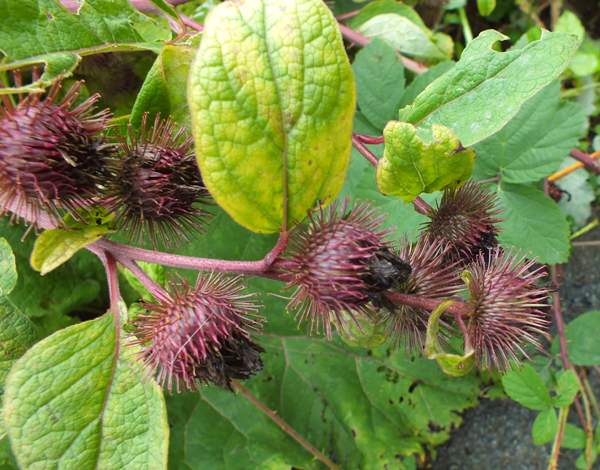Arctium minus - Lesser Burdock
Phylum: Magnoliophyta - Class: Equisetopsida - Order: Asterales - Family: Asteraceae

This prickly wildflower is not in fact a member of the dock family; it belongs to the daisy family, Asteraceae. Burdocks bloom from July until September, and they are generally found in shady places or on waste ground. Typically, the plant grows to a metre, with flower heads between 15 mm and 30 mm in diameter with florets that extend well beyond the tips of the surrounding bracts. The seed heads, or burs, have hooked bracts and become attached to the fur of animals; in this way the seeds are distributed.

Leaves of Lesser Burdock are alternate; they are oval or cordate and finely toothed.
Another burdock that you will find in Wales and throughout the UK is the Greater Burdock, Arctium lappa. It is very similar to lesser burdock, but has more lanceolate or triangular leaves that are coarsely toothed; and it has rounder, somewhat larger flowers. The flowers of Great Burdock can be up to 40 mm in diameter and do not extend significantly beyond the surrounding bracts.
Etymology
The specific epithet minus means 'smaller' or 'lesser'.
The plants shown on this page were photographed in Wales.
Sue Parker's latest ebook is a revised and enlarged second edition of the acclaimed Wildflowers in the Algarve - an introductory guide. Full details here...
Buy it for just £3.95 on Amazon...
Please Help Us: If you have found this information interesting and useful, please consider helping to keep First Nature online by making a small donation towards the web hosting and internet costs.
Any donations over and above the essential running costs will help support the conservation work of Plantlife, the Rivers Trust and charitable botanic gardens - as do author royalties and publisher proceeds from books by Pat and Sue.



